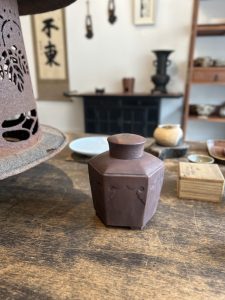もう一つのノーベル賞も興味深いところです(愛知県名古屋市千種区姫池通 骨董買取 古美術風光舎)
2025.10.07

名古屋では昨晩、美しい中秋の名月を見ることができました。「今夜の月、なんか綺麗じゃない?」と十五夜の月などには興味がない家族が気づくほどでしたので、やはりパワーが違うのでしょうか。夜風も気持ちが良く、いつまでも眺めていられる月見となりました。
さて、昨日から大きな話題となっていますが、大阪大学の坂口志文特任教授が2人のアメリカ人と共に今年のノーベル生理学・医学賞を受賞されました。3人は人間の免疫細胞が過剰に働き、自らの体を攻撃するのを抑制している「制御性T細胞」を特定したとのことです。免疫系が過剰反応を起こす疾患としては、間接リウマチや膠原病、1型糖尿病や潰瘍性大腸炎などが知られていますが、「制御性T細胞」が上手く働くようにすれば治療につながり、逆に働かないようにすれば癌細胞への免疫反応を高めることができるとのこと。
昨日のノーベル賞が発表されてから調べましたので大雑把にしか理解できていませんが、医学の進歩には欠かせないものだということは分かります。ノーベル賞の多くは未知の世界ですが、信念を持ってこつこつと研究し続ける人達の努力のおかげで、その恩恵を享受していると実感できるきっかけでもあります。
今回受賞をされた坂口教授も免疫の働きを抑制する細胞の存在に30年以上前に気づいたそうですが、当時は常識外れの考えとされ誰も目を向けてはくれなかったのだとか。アメリカで研究を続けるなか、研究費に余裕がなく、実験用のマウスの世話も妻の教子さんと共に自らしていたとのこと。「まだそんな研究をしているのか」と周囲から心無い言葉を投げかけられることもあったそうですが、「自分の目に見えているもの」を信じ研究を続けた結果が今回の受賞につながりました。会見で言葉を選びながら穏やかに話される様子に、本当に凄い人は凄さを表に出さないものだと改めて感じました。
ノーベル賞を多く受賞している国は大差をつけてアメリカが1位となっていますが、先月発表されたイグ・ノーベル賞では日本人は19年連続で受賞しています。イグ・ノーベル賞は1991年にアメリカの雑誌編集者らが創設し、「つい笑ってしまうけれど考えさせられる研究」に対して贈られます。たまに意味不明の研究もありますが、「考えさせた」ということが大切なようです。トロフィーもかなり独創的です。
今年の日本人の受賞は「シマウマのような縞模様を描いた牛はハエに刺されにくくなるか」とういう研究で農業・食品産業技術総合研究機構が生物学賞に選ばれました。
私が初めて日本人のイグ・ノーベル賞の受賞を認識したのは、2002年に犬の鳴き声を人の言葉に翻訳する「バウリンガル」を開発した「タカラトミー」が平和賞を受賞した時だったと思います。
2004年には「カラオケ」を発明した井上大祐さんに平和賞が贈られました。井上さんは特許を取らなかったためカラオケブームによる利益を得ることはできませんでしたが、1999年、アメリカの「タイム」誌に世界の夜を変えた人物として「20世紀で最も影響力のあったアジアの20人」に選ばれています。ただイグ・ノーベル賞の受賞理由は「お互いの歌を我慢強く聞くという忍耐強さを鍛える斬新な方法を編み出した」ということらしいです。どこまでも皮肉とジョークにあふれていますね。
表面的には真面目で面白みがないとされる日本人ですが、実はユーモアを受け入れる懐が深く、好きなことに打ち込む人を評価する気質があることを世に知らせる場としてイグ・ノーベル賞は最適なのではないでしょうか。
それでは、また次の機会に。(スタッフH)
Last night in Nagoya, we were able to see the beautiful Mid-Autumn Moon. Even my family, who usually have no interest in the full moon, remarked, “Isn’t tonight’s moon especially beautiful?” Perhaps its power is truly different. The night breeze felt pleasant, making it a moon-viewing experience I could have enjoyed forever.
Now, as has been a major topic since yesterday, it was announced that Professor Shimon Sakaguchi of Osaka University, along with two Americans, has been awarded this year’s Nobel Prize in Physiology or Medicine. The three identified “regulatory T cells,” which suppress human immune cells from overreacting and attacking the body. Diseases caused by immune system overreactions include rheumatoid arthritis, collagen diseases, type 1 diabetes, and ulcerative colitis. They suggest that ensuring these regulatory T cells function properly could lead to treatments, while inhibiting them could enhance the immune response against cancer cells.
I only looked into this after yesterday’s Nobel Prize announcement, so my understanding is still rough, but I grasp that this is essential for medical progress. While much of the Nobel Prize world remains unknown to me, it serves as a reminder that we benefit from the dedicated, long-term research of people who persevere with conviction.
Professor Sakaguchi, this year’s laureate, apparently noticed the existence of cells that suppress immune function over 30 years ago. At the time, however, his idea was considered unconventional, and no one paid attention. While continuing his research in the United States, he faced limited funding and even cared for the experimental mice himself, alongside his wife, Noriko. He faced harsh comments like, “Are you still doing that kind of research?” Yet, by trusting what he saw with his own eyes and persevering, his work culminated in this award. Watching him speak calmly and carefully choosing his words at the press conference, I was reminded that truly remarkable people often don’t flaunt their greatness.
While the United States leads by a wide margin in total Nobel Prizes, Japanese researchers have won the Ig Nobel Prize for 19 consecutive years. Established in 1991 by American magazine editors, the Ig Nobel Prize honors research that “makes people laugh, but also makes them think.” Though some studies seem baffling, the key seems to be that they “make you think.” The trophies are also quite original.
This year, the Japanese winner was the National Agriculture and Food Research Organization, selected for the Biology Prize for their study titled “Do cows painted with zebra-like stripes get bitten less by flies?”
I believe the first time I became aware of a Japanese winner of the Ig Nobel Prize was in 2002, when Takara Tomy won the Peace Prize for developing “BowLingual,” a device that translates dog barks into human words.
In 2004, the Peace Prize went to Daisuke Inoue for inventing “karaoke.” Though Inoue didn’t patent his invention and thus missed out on profits from the karaoke boom, he was named one of “The 20 Most Influential Asians of the 20th Century” by Time magazine in 1999 as someone who changed the world’s nights. However, the reason cited for his Ig Nobel Prize seems to be “for devising a novel method to cultivate the patience required to endure each other’s singing.” It’s overflowing with irony and humor to the very end.
While Japanese people are often perceived as serious and lacking humor on the surface, the Ig Nobel Prizes are perhaps the perfect platform to show the world that they actually have a deep appreciation for humor and a disposition that values people who are passionate about what they love.
Well then, until next time. (Staff H)
*******************
ご実家の整理やお片付けなどをされている方のご相談などが多くございます。
お片付けなどくれぐれもご無理のないようになさってくださいませ。
風光舎では古美術品や骨董品の他にも絵画や宝石、趣味のお品など様々なジャンルのものを買受しております。
お片付けをされていて、こういうものでもいいのかしらと迷われているものでも、どうぞお気軽にご相談下さいませ。
また風光舎は、出張買取も強化しております。ご近所はもちろん、愛知県内、岐阜県、三重県その他の県へも出張いたします。
まずは、お電話お待ちしております。
愛知県名古屋市千種区姫池通
骨董 買取【古美術 風光舎 名古屋店】
TEL052(734)8444
10:00-17:00 OPEN
#出張買取#骨董#古美術#骨董品#絵画#版画#茶道具#刀剣#彫刻

